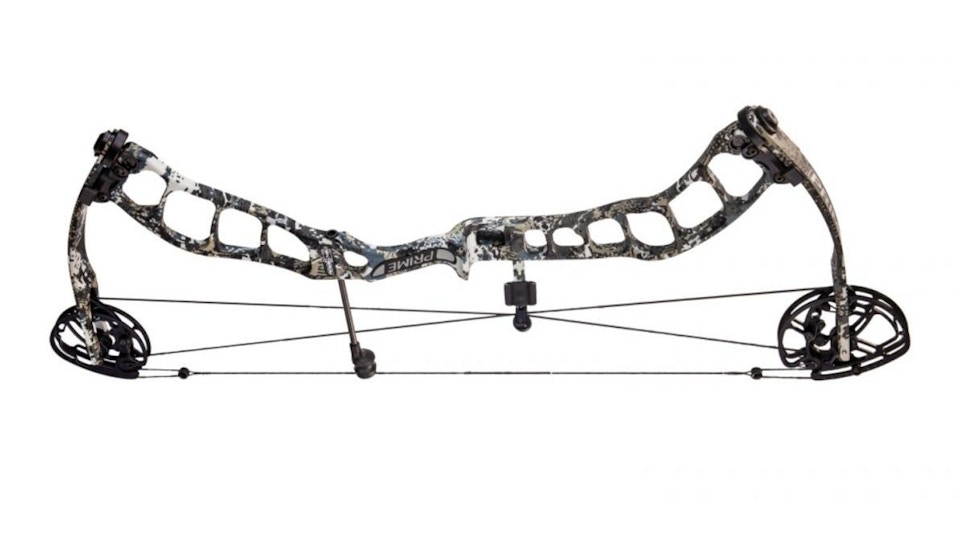The dominant design feature of Prime bows is the parallel-cam system. Though not new, for the benefit of those few who have never looked closely at a Prime bow, it consists of two parallel cams on each axle, sandwiched together with a gap between them. Strings run off each cam to a yoke a few inches away. It doesn’t take a mechanical engineer to see the advantages of such a system. It virtually eliminates cam lean and allows the string to run down the vertical center of the bow (as opposed to being slightly offset). It reduces torque and facilitates straight nock travel. That should make for an easy-tuning, forgiving, tack driver of a bow — and it does.
When I tested the Prime Ion two years ago I suggested that if it were a vehicle it would be not a sports car but a pickup truck, designed more for getting the job done efficiently than with any sexy attributes. A recent discussion with a G5 engineer has convinced me that the focus is still on achieving the desired result. At the same time, some design changes have, while not changing the essential nature of Prime bows, definitely added some appealing new qualities to their latest offering.

First, the parallel cams themselves have been tweaked. The new TRK cams are smoother than previous incarnations and offer an adjustable letoff up to 85 percent. What is perhaps more significant, and certainly more remarkable, is their increased efficiency. While as a rule of thumb shortening a draw length by an inch means a decrease of roughly 10 feet per second, the TRK cams cut that loss to about five feet per second. No big deal if you shoot a 30-inch draw length, but important if you shoot a 27- or 28-inch draw length.
The name Centergy derives from the fact that Prime moved the vertical center of the bow to the top of the grip. (This required making the top cams slightly larger than the bottom cams so that more string pays out at full draw, thus maintaining level nock travel.) At the same time, they moved the center of gravity below the center of the bow, as opposed to above it, to obtain the kind of balance that shooters often use stabilizers to achieve. The result of this (Prime calls it a Center Balanced Targeting System) is a steadier hold at full draw. Using laser tests, Prime concludes the average shooter holds 42 percent steadier at full draw using the Centergy as compared to other bows.
The option of cable stops or limb stops for a firmer back wall is new, but retained from last year’s Prime Rize is the 82X aluminum riser, making Prime’s bows the strongest and most rigid aluminum risers in production by a significant margin. Also back is the Sherpa Attachment Mounting System, which allows, in addition to the usual accessories, the attachment of devices such as action cameras. The adjustable Flexis AR cable guard system with roller guards is back as well.
In terms of appearance, the Centergy retains Prime’s somewhat Spartan appearance. Fit and finish are excellent, and the test bow passed the scratch test and revealed no visible flaws or machining marks.
Shooting the Bow
All accessories installed without difficulty. Limb bolts were tight but smooth, and turned without slipping or chattering. Tuning presented no problems.
At 4.3 pounds, the Centergy is not a light bow. Balance is good. The grip is a standard side-plate style, skinny but ergonomic and comfortable. Prime does not tend to hype the smoothness of their bows, but in fact the Centergy is exceptionally smooth in an era of smooth-drawing bows. It climbs steadily to a peak with an equally steady descent. The drop into the valley is almost imperceptible. Limb stops make for a very firm back wall (with optional cable stops for shooters who prefer those), but there is absolutely no jolt at the end, and despite a fairly narrow valley, the TRK cams exhibit no grabbiness. There is the expected slight hop forward at the shot, but no hand shock and only the faintest vibration.

The bow is indeed rock steady at full draw. Whether it is significantly more steady than previous Prime bows is hard to say, since Prime bows have always exhibited that attribute. And that attribute, along with tack-driving accuracy and a generally very forgiving nature, makes it a great choice for beginning shooters or for any bowhunter who likes a reasonably fast, pleasant-shooting bow and who thinks he might like as much forgiveness as he can get when Mr. Big steps into a shooting lane — which should, frankly, be just about every bowhunter out there.
For more information, call (810) 392-8431 or visit www.g5prime.com.






